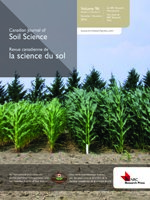Kowalenko, C. G. and Ihnat, M. 2011. Fraser oat and soil extraction responses to zinc and manganese applied to a soil with historic limestone treatments. Can. J. Soil Sci. 91: 647-659. A field trial initiated in 1979 examined the possibility of zinc (Zn) and manganese (Mn) deficiencies when limestone was applied to an acidic (approximately pH 5) soil at Agassiz, British Columbia. The results from an initial phase of the study conducted from 1979 through 1985 with cauliflower as the test crop and foliar Zn and Mn have been reported. This study reports on a follow-up to that study, with a focus on the effect of historic limestone treatments on oats with soil rather than foliar applications of Zn and Mn. Oats was selected for this phase, since it is widely assumed to be sensitive to low Mn contents, and was grown from 1988 through 1990. The limestone treatments were made in 1979, 1981 and 1986 at two rates (9 and 19 Mg ha-1 each time). The micronutrient treatments were applied to the soil in each of the 3 yr of oat growth to plots that did not have previous soil micronutrient applications. Quantitative visual measurements showed that limestone applications reduced the vigor of common groundsel (Senecio vulgaris L.) weed when the plot area was being fallowed in 1987. In 1988, nitrogen (N) deficiencies were confirmed by visual observations and soil and plant measurements, especially in the treatment with no limestone applied. Adjustments were made to the amount of N fertilizer applied in 1989 and 1990 to eliminate the complication of N deficiencies to the assessment of the effects of limestone on potential Zn and Mn deficiencies. Visual assessment, and plant and soil measurements confirmed that adequate N had been applied. Visual symptoms, dry matter measurements and nutrient contents in the crop showed that Mn and, to a lesser extent, Zn deficiencies were induced by the historic applications of limestone. The effects were quite small showing that these micronutrients were only marginally deficient. Mehlich-3 solution tended to extract more calcium (Ca) and less Mn and Zn from limestone-treated soil than control soil, similar to the response of the crop, showing the potential of this soil test to predict limestone-induced Mn and Zn deficiencies. Although plant uptake and corresponding soil extractions of Ca, Zn and Mn were consistent with regard to treatment effects, the relationships were weak, but provide sufficient information for using soil measurements to assist designing better follow-up studies. Plant measurements showed unexpected increases of iron (Fe) uptake by the crop with increased limestone application rates, whereas, limestone had the opposite effect on soil extraction of the element. Further work is required to determine why this occurred.
How to translate text using browser tools
1 July 2011
Fraser oat and soil extraction responses to zinc and manganese applied to a soil with historic limestone treatments
C. G. Kowalenko,
M. Ihnat
ACCESS THE FULL ARTICLE
It is not available for individual sale.
This article is only available to subscribers.
It is not available for individual sale.
It is not available for individual sale.

Canadian Journal of Soil Science
Vol. 91 • No. 4
July 2011
Vol. 91 • No. 4
July 2011
absorption des éléments nutritifs par les plantes
Carence en oligoéléments
carence induite par le chaulage
crop growth response
extraction du sol par la méthode Mehlich-3
limestone-induced deficiency
Mehlich-3 soil extraction




